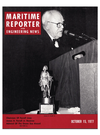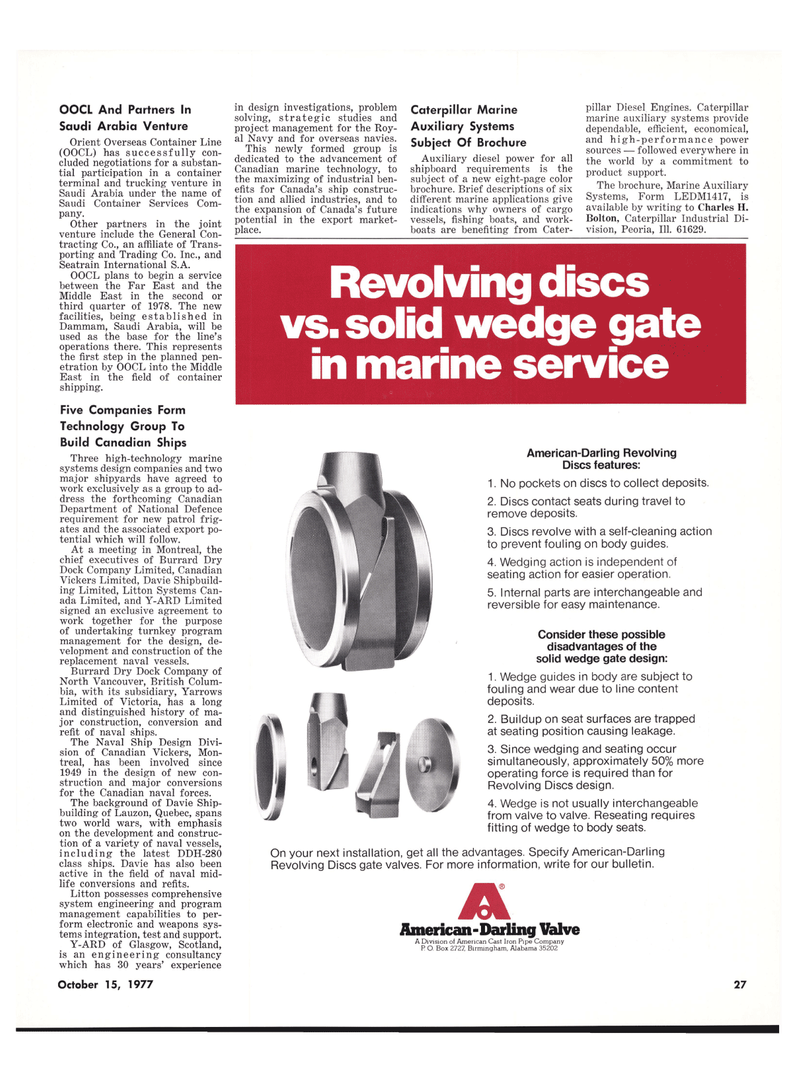
Page 25: of Maritime Reporter Magazine (October 15, 1977)
Read this page in Pdf, Flash or Html5 edition of October 15, 1977 Maritime Reporter Magazine
OOCL And Partners In
Saudi Arabia Venture
Orient Overseas Container Line (OOCL) has successfully con- cluded negotiations for a substan- tial participation in a container terminal and trucking venture in
Saudi Arabia under the name of
Saudi Container Services Com- pany.
Other partners in the joint venture include the General Con- tracting Co., an affiliate of Trans- porting and Trading Co. Inc., and
Seatrain International S.A.
OOCL plans to begin a service between the Far East and the
Middle East in the second or third quarter of 1978. The new facilities, being established in
Dammam, Saudi Arabia, will be used as the base for the line's operations there. This represents the first step in the planned pen- etration by OOCL into the Middle
East in the field of container shipping.
Five Companies Form
Technology Group To
Build Canadian Ships
Three high-technology marine systems design companies and two major shipyards have agreed to work exclusively as a group to ad- dress the forthcoming Canadian
Department of National Defence requirement for new patrol frig- ates and the associated export po- tential which will follow.
At a meeting in Montreal, the chief executives of Burrard Dry
Dock Company Limited, Canadian
Vickers Limited, Davie Shipbuild- ing Limited, Litton Systems Can- ada Limited, and Y-ARD Limited signed an exclusive agreement to work together for the purpose of undertaking turnkey program management for the design, de- velopment and construction of the replacement naval vessels.
Burrard Dry Dock Company of
North Vancouver, British Colum- bia, with its subsidiary, Yarrows
Limited of Victoria, has a long and distinguished history of ma- jor construction, conversion and refit of naval ships.
The Naval Ship Design Divi- sion of Canadian Vickers, Mon- treal, has been involved since 1949 in the design of new con- struction and major conversions for the Canadian naval forces.
The background of Davie Ship- building of Lauzon, Quebec, spans two world wars, with emphasis on the development and construc- tion of a variety of naval vessels, including the latest DDH-280 class ships. Davie has also been active in the field of naval mid- life conversions and refits.
Litton possesses comprehensive system engineering and program management capabilities to per- form electronic and weapons sys- tems integration, test and support.
Y-ARD of Glasgow, Scotland, is an engineering consultancy which has 30 years' experience in design investigations, problem solving, strategic studies and project management for the Roy- al Navy and for overseas navies.
This newly formed group is dedicated to the advancement of
Canadian marine technology, to the maximizing of industrial ben- efits for Canada's ship construc- tion and allied industries, and to the expansion of Canada's future potential in the export market- place.
Caterpillar Marine
Auxiliary Systems
Subject Of Brochure
Auxiliary diesel power for all shipboard requirements is the subject of a new eight-page color brochure. Brief descriptions of six different marine applications give indications why owners of cargo vessels, fishing boats, and work- boats are benefiting from Cater-
A
American-Darling Valve
A Division of American Cast Iron Pipe Company
P O. Box 2727, Birmingham, Alabama 35202 pillar Diesel Engines. Caterpillar marine auxiliary systems provide dependable, efficient, economical, and high-performance power sources — followed everywhere in the world by a commitment to product support.
The brochure, Marine Auxiliary
Systems, Form LEDM1417, is available by writing to Charles H.
Bolton, Caterpillar Industrial Di- vision, Peoria, 111. 61629.
Revolving discs vs. solid wedge gate in marine service
American-Darling Revolving
Discs features: 1. No pockets on discs to collect deposits. 2. Discs contact seats during travel to remove deposits. 3. Discs revolve with a self-cleaning action to prevent fouling on body guides. 4. Wedging action is independent of seating action for easier operation. 5. Internal parts are interchangeable and reversible for easy maintenance.
Consider these possible disadvantages of the solid wedge gate design: 1. Wedge guides in body are subject to fouling and wear due to line content deposits. 2. Buildup on seat surfaces are trapped at seating position causing leakage. 3. Since wedging and seating occur simultaneously, approximately 50% more operating force is required than for
Revolving Discs design. 4. Wedge is not usually interchangeable from valve to valve. Reseating requires fitting of wedge to body seats.
On your next installation, get all the advantages. Specify American-Darling
Revolving Discs gate valves. For more information, write for our bulletin.
October 15, 1977 27

 24
24

 26
26
